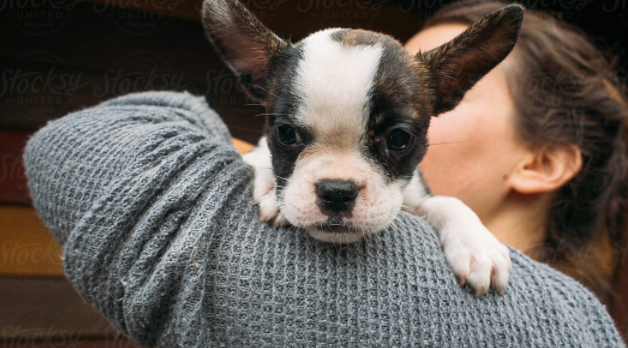How To Build Trust With Your Dog in 3 Ways
5/24/23

It’s truly rewarding when you win the love and trust of your pup, isn’t it? The joyful greeting when you get home, the exhilarating games of tug-of-war, and the after-dinner couch cuddles are the heartwarming results of time spent fostering that trust.
However, all dogs possess their own unique personalities, and some may warm up more quickly to their human companions than others. Establishing trust with your new friend and nurturing it regularly are the essential component to a healthy and solid relationship.
Once you know how to build trust with your dog, you can help to make them feel right at home and start learning the best way to crate train a puppy or how long does it take to potty train a dog. While there are infinite dog training methods on how to gain their trust, below, you’ll find three techniques that have proven to be successful for many new dog owners.
You’ll be cuddling on the couch in two wags of the tail.
#1 Find Opportunities for Play and Positive Reinforcement
Playing with your dog is a tried and true way to get him to trust you—plus, it’s a clever excuse for you both to have some fun.
Try some of these games when you’re learning how to earn a dog’s trust:
- New dog, new tricks – Your dog’s trust in you goes hand-in-hand with his confidence. Teach him easy new tricks, like “sit” and “paw,” and offer him high-value rewards (like yummy treats and praise) for any progress he makes. This boosts not only his confidence in himself, but also his confidence that you’ll reward his good behavior.
- Hide and seek – Dogs are terrific seekers—and sniffers. When you give your dog a task at which he can excel (and receive lots of rewards), like finding a hidden toy or treat, you once again give him a chance to build his confidence. Plus, this game provides an opportunity for him to explore his environment and become comfortable in his new home while also being a great way for them to mimic their ancestral environment by hiding rewards for them to sniff out.
- Dog’s choice – “Explore training” lets your dog decide what kind of fun he wants to have. Give him an option of general play by placing a toy or box in front of him. When he reacts to a particular object—either by sniffing, pawing, or even looking at it—reinforce the interaction with a reward. Continue to reinforce the dog training or play as he gets more comfortable, so he knows he’s in a space where relaxation and healthy exploration is rewarded.
Whether you’re teaching him new tricks or introducing a toy into the mix, play and positive reinforcement techniques are a dynamic way for you and your dog to get to know each other.
#2 Be Mindful of Body Language
Unless your dog is one of the giant breeds, like Cane Corsos and Mastiffs, you’re probably quite a bit taller than they are. Since this can sometimes be intimidating for pups, try to mitigate your height differences by sitting on the floor. Getting on their level lets them know that you aren’t a threat.
You can use body language in other ways that respect your dog’s sensibilities and space, too:
- Approach at an angle – This is the way dogs tend to approach each other, too. Turn your body slightly away from your pup, and try not to sustain eye contact. Facing them head on can sometimes be interpreted as an act of aggression.
- Ignore them – Allow your pup to come to you. If they choose to approach you on her own terms, reward the dog's good behavior, then go back to what you were doing before. Soon they’ll be requesting your focused attention—and the rewards that come along with it.
Thinking and moving in ways that they’ll interpret as respectful shows them that you understand them, and could help them learn to relax around you and others.
#3 Practice Patience
Whether it takes you minutes or years to warm up to a new friend, we can all relate to feelings of uncertainty when we’re first introduced to someone new. Especially if they are a rescue dog with an unknown history, it’s impossible to know what he’s been through and why he’s having a hard time trusting you.
But you can know how to respect his boundaries. Allow him to approach you and reward him when he does (rather than forcing him into situations that make him feel uncomfortable). Even if this means foregoing the couch cuddles and tug-of-war for a while, it’ll be well worth it once you’ve built a trusting relationship with your new rescue dog.
Darwin’s Natural Pet Products: Pet Food You Can Trust
Finding the right diet for your dog’s size, age, and breed is just as important as building trust with him. Darwin’s Natural Pet Products is True Raw, just like the food your dog’s ancestors delighted in long ago.
Inspired by nature, informed by science—with Darwin’s natural dog food, you can provide your dog with the raw dog food he was built to enjoy, giving him one more terrific reason to trust you.
Sources:
RSPCA. 5 training games that will help build your dog's trust. https://www.rspca.org.uk/-/5-training-games-that-will-help-build-your-dog-s-trust
K9 of Mine. How to Get a Scared Dog to Trust You: Canine Trust Building! https://www.k9ofmine.com/how-to-get-scared-dog-to-trust/



